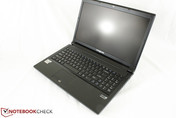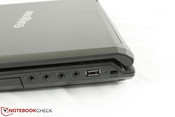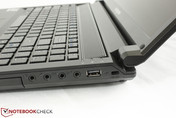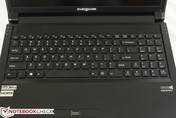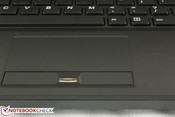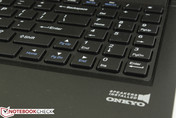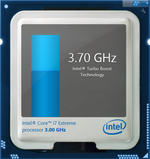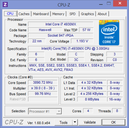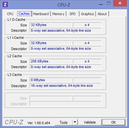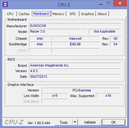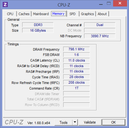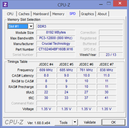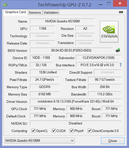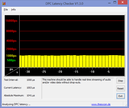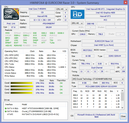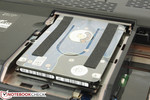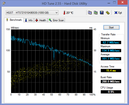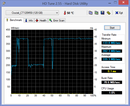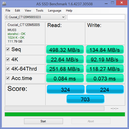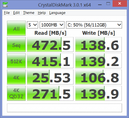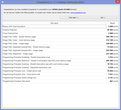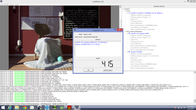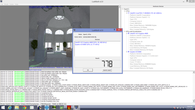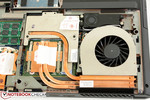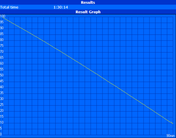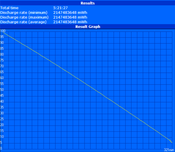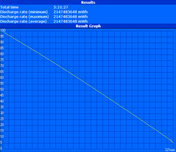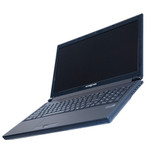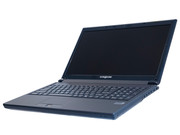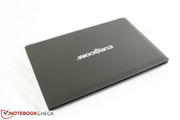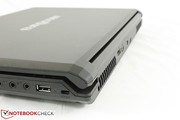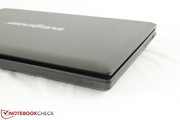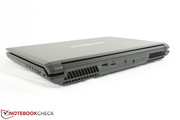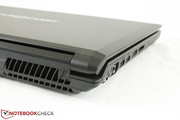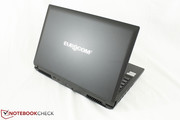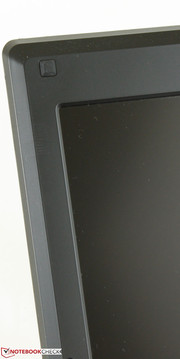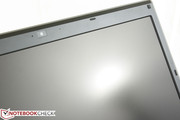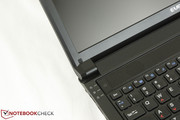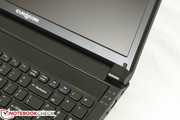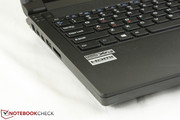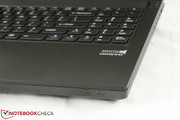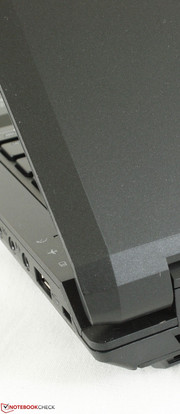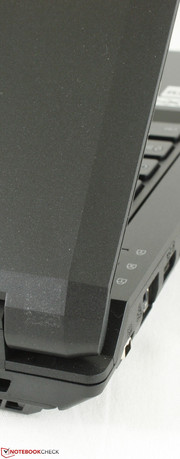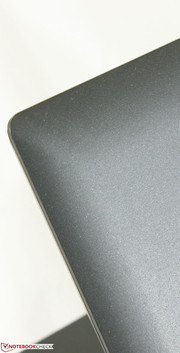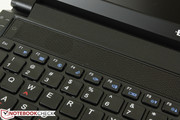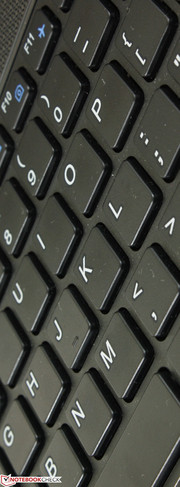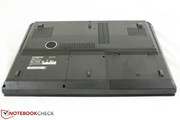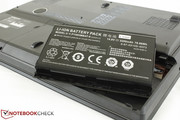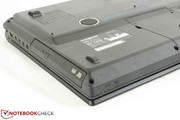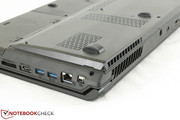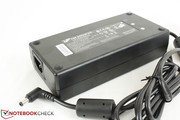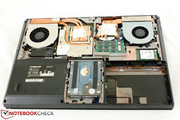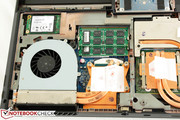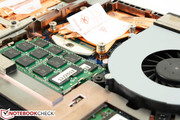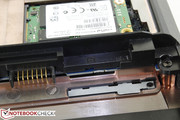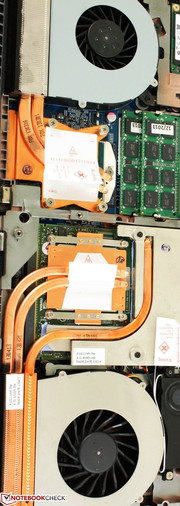Review Eurocom Racer 3W (Clevo P151SM) Notebook

Eurocom's highly configurable 15.6-inch Racer and Racer 2.0 lineup continues with the Racer 3W. The latest iteration brings along a thinner chassis alongside the expected Haswell update with high-end CPU, GPU and HDD/SSD options. Even the lowest specced options - a 2.4 GHz Core i7-4700MQ, Quadro K1000M and 16 GB DDR3 RAM - are nothing to scoff at.
Our model today is equipped with the highest configurable components including a 3 GHz Core i7-4930XM, Quadro K5100M GPU with 8 GB GDDR5 VRAM, 16 GB DDR3-1600 RAM, a primary Crucial 128 GB SSD and a 1080p matte display rated for 95% NTSC coverage. Such a configuration will run about $4500 USD - a cost not too uncommon given the extreme hardware inside.
Since the chassis is very similar to the Clevo P150SM, we refer to our review of the Schenker XMG W503 for more details on external features such as the case and connectivity options. Instead, we will focus on some of the impressive benchmarks that this Eurocom can throw out and compare it to the current mobile workstation competition.
Case
Case quality and design amongst Eurocom models are more or less very similar as the chassis are based on Clevo barebones. Surfaces are matte on all sides and slightly textured with a rigid feel that reflect the high-end status of the notebook. The rough texturing hides fingerprints and grease quite well at the cost of visual appeal; other workstations like the HP ZBook 15 or similarly sized DTRs employ brushed aluminum or glossy finishing to stand out from the crowd. Nonetheless, the manufacturer has managed to reduce the thickness of the chassis from 51 mm of the Racer 2.0 down to 43 mm.
In terms of weight, the Racer 3W is most similar to the Dell Precision M4800 (3.18 kg), lighter than an MSI GT60 (3.35 kg), and heavier than both the Precision M3800 (2.00 kg) and ZBook 15 (2.82 kg). Of course, the Racer is also more heavily equipped with stronger performance than these listed competitors as well.
Other physical aspects including hinge stiffness and base rigidity feel just right for a notebook this class. The lid, though still very good, could have been more rigid as we found it a bit on the easy side to twist back and forth. The right side of the notebook can also depress more easily than the left side due to the optical drive underneath and its hollow space. Beyond these minor complaints, we're generally pleased with the quality of the conservatively designed case.
Connectivity
Physical ports abound on the Racer 3W from FireWire 400 to eSATA to Mini DisplayPort, all of which are easily accessible from the sides or rear. They are also all relegated to the back half of the notebook so both right- and left-handed users can have a relatively untangled workspace.
For future models, it would be nice to see an HDMI-in, similar to what is included in the large 18.4-inch Alienware 18.
Communication
WLAN is provided by an Intel dual-band (2x2) Wireless-ac 7260 PCIe half-mini card with integrated Bluetooth 4.0. The module provides a theoretical transfer rate of 837 MB/s on 802.11ac or 300 MB/s on 802.11n. We ran into no connectivity issues when connecting to a home network.
Users can insert a SIM card in the slot underneath the battery for WWAN functionality if the configuration supports it.
Accessories
Out-of-the-box accessories include three different discs (Media Suite 8, Drivers/Utilities/Manual and a Calibration Profile disc) and a small User's Guide with detailed hardware and software instructions. It is a little odd to not include a cleaning cloth, though this is but a minor footnote.
Eurocom offers additional accessories such as external optical drives, USB port replicators, adapters and other cables. There is no proprietary docking port so these accessories are generic by nature.
Warranty
A standard 1-year warranty with tech support is included with all new purchases. This can be upgraded to 2 years or 3 years for $165 or $295, respectively.
Input Devices
Keyboard
Compared to the Racer 2.0, the Racer 3W has dropped the beveled layout in favor of the now more popular Chiclet setup (34 cm x 11 cm). This provides a cleaner look while increasing the distance between keys to reduce mistypes. Fortunately, travel has remained about the same if not a bit deeper than before for more satisfying feedback. Keystrokes are relatively quiet and the full-size arrow keys and numpad return from the previous Racer model.
On the downside, the wider spacing between keys has forced some rearrangements, specifically on the numpad. Whereas the older Clevo P150EM model has a numpad consisting of four columns, the Racer 3W has a numpad consisting of only three columns, so some keys like plus (+), star (*), and period (.) had to be shifted to different locations. Of course, users will quickly acclimate to the slight change after regular use of the keyboard.
Touchpad
The small size of the touchpad (8.5 cm x 4.5 cm) is a bit disappointing, though to be fair the Precision M4800 and MSI GT60 workstations have small touchpads not ideal for multi-touch use as well. Nonetheless, the competing ZBook 15 and Precision M3800 have touchpads with larger surface areas for easier mouse navigation.
Even so, the Racer 3W touchpad is responsive without any random jumps or noticeable lag. The hardware is powered by Synaptics V7.2 and the textured rough surface is identical to the surrounding palm rests and are separated only by the slight elevation change around the edges. Because of its diminutive size, it is a little too easy to bring up the Windows 8 right-column dock by accident during regular use.
The two mouse buttons immediately adjacent to the touchpad are also small and textured similarly, but the feedback and resulting audible click feel weak and lack the high quality tone that we expect from a workstation. The sound, for example, feels hollow and the buttons themselves feel thin. In terms of functionality, they are as responsive as the touchpad with few to no input errors.
Display
Our 15.6-inch matte display uses the same AUO B156HW01 V4 panel as the Eurocom X3 and a number of other high-end workstations. Other options, including a 1080p glossy version or a less expensive 900p version, are available for lower prices. It would have been nice to see higher QHD options as they are becoming more common amongst top-of-the-line workstations and Ultrabooks.
Subjectively, pictures are crisp and colors appear deeper than they do on less expensive notebooks. We noticed no obvious screen-door effect or other abnormalities on the display.
Our measured contrast ratio of 446:1 is close to the advertised 500:1. The average brightness of almost 250 nits is sufficient for indoor use, though maximum brightness will drop to about 217 nits if running on batteries. This is brighter than the MSI GT60, but falls short of some newer competitors like the Precision M3800/M4800 and ZBook 15. While this limits its outdoor usability, the matte panel should have no issues under typical indoor ambient lighting conditions.
| |||||||||||||||||||||||||
Brightness Distribution: 89 %
Center on Battery: 217.4 cd/m²
Contrast: 446:1 (Black: 0.599 cd/m²)
ΔE ColorChecker Calman: 6.09 | ∀{0.5-29.43 Ø4.77}
ΔE Greyscale Calman: 6.62 | ∀{0.09-98 Ø5}
87.29% AdobeRGB 1998 (Argyll 1.6.3 3D)
89.3% AdobeRGB 1998 (Argyll 3D)
97.4% sRGB (Argyll 3D)
81.3% Display P3 (Argyll 3D)
Gamma: 2.43
CCT: 6818 K
Color space coverage is a measured 87.41 percent of AdobeRGB and 89.41 percent of sRGB with the X-Rite i1Pro Display 2, or close to the claimed 95 percent NTSC coverage. Results are similar to the display of the Eurocom Racer 2.0 as both models include panels appropriate for digital graphics work. This is compared to cheaper panels or workstations where 60 percent coverage or less is common.
Further display measurements were performed with an X-Rite i1Basic Pro 2 spectrophotometer. The display had a cool temperature and bluish tint before calibration as evident by the off RGB balance, which is common amongst many notebooks. This improved dramatically after calibration with a cleaner grayscale and better color accuracy across all saturation levels. Most colors remain around 5 DeltaE units or better from the ideal with green performing just a bit worse than others. Still, we recommend using the included calibration disc to further fine tune the display as needed.
Outdoor use is possible under shade, but the display backlight is simply not strong enough to overcome direct sunlight. The lowered maximum brightness when running on batteries even on High Performance suggests that the notebook prioritizes longer runtimes over outdoor usability. This makes sense for a workstation this size where it should be spending more time indoors than out.
Viewing angle stability is standard for a TN panel where colors will degrade if viewing from below the normal or become washed out if from above the normal. On the Racer 3W and its higher quality TN panel, the acceptable viewing window before picture quality drops is wider than on TN panels on less expensive notebooks. We observed no purple or yellow tint at different angles like we did on the Precision M3800 and Racer 2.0, respectively.
Performance
The Racer 3W can be configured from a choice of five different Haswell cores: an i5-4200M, i7-4700MQ, i7-4800MQ, i7-4900MQ or i7-4930MX. The model on hand houses the latter CPU option, which is roughly 10 percent faster than the i7-3940XM, otherwise known as the fastest consumer quad-core processor from the Ivy Bridge generation. Needless to say, this 57 W Haswell CPU should satiate power-hungry workstation users just fine. In the Racer 3W, the cores will idle at 800 MHz when under the Power Saver profile.
For more benchmarks and information on the i7-4930MX, see our dedicated CPU page here.
As with a handful of other Haswell cores, the CPU includes the integrated HD 4600 GPU. A more exhaustive review of the integrated Intel GPU can be seen in our dedicated review page here as this review will instead focus on the more extreme Nvidia Quadro K5100M dGPU.
Processor
Because of the limited number of consumer notebooks that carry an i7-4930MX option and the costs that such a configuration entail, we have few other notebooks with the same CPU in our database. In fact, the few that we do have are other Eurocom models including the Eurocom X3 and X7 with the Alienware 18 as our third.
The Racer 3W excels at multi-thread benchmarks with scores higher than the models mentioned above. For example, wPrime and CineBench 11.5 return scores of 217 seconds and 7.62 points, respectively, which essentially puts the notebook near the very top of our database with regards to these two benchmarks. Similarly, its high Fire Strike Physics score of 9824 points is matched by very few other notebooks.
Single-thread performance is a different story as the Racer 3W returns the slowest score of about 535 seconds in Super Pi 32M with respect to the notebooks above. Of course, "slowest" in this context is still faster than over 90 percent of consumer notebooks in the market, so this should not be a concern. Unsurprisingly, average scores all-around are roughly similar to the i7-3940XM.
System Performance
PCMark 7 and PCMark 8 scores are some of the highest in our database yet again. With a final score of 6388 points in the former benchmark, this is very close to the maximum of 6624 points currently held by the Sony Vaio SV-Z13. The 13.1-inch Sony is able to edge out the Racer 3W with two SSDs in RAID 0 to balance out the lower i7-3612QM and HD 4000 specs. Similarly, PCMark 8 scores are close to those of the high-end Asus ROG G750JH and other notebooks with extreme hardware or RAID 0 configurations.
The standard Windows 8 Experience Index has been removed as of the Windows 8.1 update, but fortunately the scores are retrievable via PowerShell. The CPU, RAM and SSD share very similar scores implying a balanced system for heavy multi-tasking and workloads. The GPU is the bottleneck of the Racer 3W, though this can be seen as a compliment as the equipped K5100M is the fastest mobile Quadro card available as of this writing.
| PCMark 7 Score | 6388 points | |
| PCMark 8 Home Score Accelerated | 4368 points | |
| PCMark 8 Creative Score Accelerated | 5951 points | |
| PCMark 8 Work Score Accelerated | 4953 points | |
Help | ||
Storage Devices
Storage is provided by a 120 GB Crucial CT120M500SSD3 mSATA and a secondary 1 TB Hitachi HTS721010A9E630 2.5-inch SATA drive. The 7200 RPM HDD is very fast in itself with an average transfer rate of 101.7 MB/s in HD Tune. Most 5400 RPM drives, for example, can be about 20 MB/s slower in less expensive notebooks. Similarly, the Crucial SSD provides surprisingly balanced write performance across all file sizes according to CDM. Its maximum read speed is good as well, but it does not break the 500 MB/s barrier unlike the Samsung SSD in the Precision M4800.
The wide configurable options of the Racer 3W allow for up to 4 storage drives: 2x mSATA SATA 6G and 2x 2.5-inch SATA III. Our notebook only comes with the two drives mentioned above, but users can install in pairs for dual RAID 0/1/5/10 setups. Installing these additional drives will require additional disassembly. A fifth drive can be added via an optical drive bay bracket at the cost of an optical drive.
Graphics Card
Only Nvidia Quadro options are available directly from Eurocom spanning the range of Kxx00M discrete cards. This includes the low-end K1000M, high-end K5100M and almost everything in between. Cards can be easily swapped and installed on the MXM 3.0b slot.
The K5100M in our configured model is a monster of a card with 8 GB GDDR5 VRAM, 771/900 MHz core/memory and a 100 W TDP. When idling or inactive, the K5100M will operate at only 135/162 MHz for power-saving purposes. Its massive amount of 1536 CUDA cores makes this GPU the workstation counterpart to the consumer GTX 780M. On paper, this makes the K5100M one of the fastest workstation cards.
Gaming-centric benchmarks like 3DMark 11 and 3DMark 2013 prove this statement despite the non-gaming focus of the Quadro card. The Racer 3W returns similar results as the Asus ROG G750JH, Maingear Nomad 15 and Alienware 17, all of which sport GTX 780M graphics and are the gaming crests of their respective manufacturers.
In real-world gaming scenarios, however, expect the K5100M to a notch slower than the dedicated GTX 780M gaming card due to unique optimizations of workstation cards and other software differences. The slower clock speeds of the K5100M compared to a standard GTX 780M (771/3600 MHz vs. 823/5000 MHz) are responsible for the lowered frame rates as well.
| 3DMark 06 Standard Score | 25193 points | |
| 3DMark Vantage P Result | 24795 points | |
| 3DMark 11 Performance | 7155 points | |
| 3DMark Ice Storm Standard Score | 96644 points | |
| 3DMark Cloud Gate Standard Score | 17583 points | |
| 3DMark Fire Strike Score | 4392 points | |
| 3DMark Fire Strike Extreme Score | 2171 points | |
Help | ||
| low | med. | high | ultra | |
|---|---|---|---|---|
| Sleeping Dogs (2012) | 123 | 91 | 31 | |
| Guild Wars 2 (2012) | 58 | 39 | ||
| Tomb Raider (2013) | 203 | 128 | 58 | |
| StarCraft II: Heart of the Swarm (2013) | 122 | 106 | 65 | |
| BioShock Infinite (2013) | 157 | 132 | 49 | |
| Metro: Last Light (2013) | 91 | 60 | 33 | |
| Company of Heroes 2 (2013) | 59 | 58 | 20 |
CAD performance according to SpecViewPerf 11 is well ahead of lesser Nvidia Quadro cards, sometimes substantially. The EnSight and Siemens/Tcvis applications in particular see the largest gains over models like the ZBook 15 or Precision M4800. The high-end AMD FirePro M6000 in our Precision M6700 model is also no match for the Nvidia card under the same benchmarks. Applications that take advantage of OpenGL instead of the DirectX API will see the greater benefit from a Quadro card.
OpenCL (GPGPU) performance according to LuxMark and CompuBench 1.1.3 are again similar to a GTX 780M, if not slightly higher. The K56-3N2 notebook, for example, scores 381 and 738 samples/s in LuxMark Room and Sala, respectively, compared to 415 and 778 samples/s on the Racer 3W. Of course, utilizing the CUDA platform is an option as well for the Nvidia card.
Emissions
System Noise
Two system fans cool the CPU and GPU, respectively, each with their own independent heat pipes and exhaust grilles. At 60 mm in diameter, the GPU fan is both larger and deeper than the 50 mm CPU fan.
With so much power under the hood, fan noise is a light whir at best and a car engine at worst. Its idling fan noise of about 35 dB(A) is louder than the Precision M3800/M4800 models and about the same as the ZBook 15. On the other hand, these comparisons may not be fair due to the much faster hardware in the Racer 3W. When compared to other similarly equipped notebooks like the Schenker XMG P502, the idling fan noise is typical for a Clevo barebones. Do note, however, that the Racer 3W is not afraid to get noisy during use, so expect the fan to pulsate even during light multi-tasking.
When under maximum load, fan noise will increase in a stepwise manner from an idling 35 dB(A) to 43.9, 46.7, 51.6, 53.3, 57.4 and finally to 59.4 dB(A). Our high ~60 dB(A) result was only attained with maximum synthetic stress on both the CPU and GPU simultaneously; Such a condition is unrepresentative of real-world use. Instead, the notebook will have a tendency to settle at the 51.6 dB(A) range when gaming.
Noise level
| Idle |
| 34.9 / 35 / 35.1 dB(A) |
| DVD |
| 43 / 47 dB(A) |
| Load |
| 46.7 / 59.4 dB(A) |
 | ||
30 dB silent 40 dB(A) audible 50 dB(A) loud |
||
min: | ||
Temperature
Idling surface temperatures are quite uniform with no major hot spots. The bottom quadrant near the front of the notebook is notably warmer than the rest of the notebook, but not warm enough to be uncomfortably hot to the skin. The secondary HDD lies under this panel and is responsible for the added heat, so removing or installing a 2.5-inch SSD will reduce the immediate surface temperature by a noticeable amount.
Surface temperatures remain surprisingly cool under sustained maximum load. Many of the quadrants change little in temperature compared to their idling states as only the rear areas show appreciable differences. Such a result is preferable as it allows for hands to rest on the palm rests and type comfortably no matter the workload. This is compared to the MSI GT60 and Precision M3800 where some quadrants can reach 40 degrees C or higher.
(+) The maximum temperature on the upper side is 35.2 °C / 95 F, compared to the average of 40.4 °C / 105 F, ranging from 21.2 to 68.8 °C for the class Gaming.
(+) The bottom heats up to a maximum of 37.4 °C / 99 F, compared to the average of 43.3 °C / 110 F
(+) In idle usage, the average temperature for the upper side is 25.4 °C / 78 F, compared to the device average of 33.9 °C / 93 F.
(+) The palmrests and touchpad are cooler than skin temperature with a maximum of 30.8 °C / 87.4 F and are therefore cool to the touch.
(±) The average temperature of the palmrest area of similar devices was 28.8 °C / 83.8 F (-2 °C / -3.6 F).
Stress Test
We stress the notebook with Prime95 and FurMark while running CPU-Z, GPU-Z and HWiNFO64 monitoring tools to observe any potential throttling or stability issues.
With only Prime95 active, the CPU was able to operate at a stable 3.4 - 3.5 GHz range. Compared to the base 3.0 GHz speed, the Racer 3W can maintain a stable Turbo Boost of about 400 - 500 MHz without issues under this condition. CPU temperature jumped quickly to about 90 degrees C.
With only FurMark active, the GPU was able to operate at a stable and consistent 770.8/900 MHz Core/Memory. While the memory on the K5100M is officially rated at 3600 MHz, GPU-Z normally reports half this effective value (if DDR) or even a quarter (if QDR). The reported 900 MHz suggests quad pumping per memory clock cycle of the GPU. In terms of temperature, the GPU rises more slowly and steadily before flat-lining at around 85 degrees C.
With both Prime95 and FurMark active simultaneously, the CPU was able to operate at a stable 3.3 - 3.5 GHz, but will infrequently drop to its base 3 GHz lasting for only a couple of seconds. Meanwhile, the GPU maintained its usual 770.8/900 MHz speeds and never dipped to slower numbers. Interestingly, GPU temperature dropped to about 78 degrees C down from >85 C, likely due to the overdrive GPU fan when both CPU and GPU processors are under high stress.
We experienced no instability issues during the stress test and a quick 3DMark 11 run immediately following the test returned no hints of throttling.
Running on batteries, however, will reduce 3DMark 11 scores from 7148 points to 3785 points (GPU) and 8763 points to 5136 points (Physics). This is due to the reduced maximum speeds of both the CPU and GPU to just 1.7 GHz and 405/400 MHz, respectively, if not on AC power. Not only is Turbo Boost disabled, but running on the High Performance profile will not lift the low operating ceilings of either processor.
Speakers
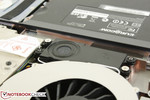
Sound is provided by two 2.2 W speakers plus one 2.5 W subwoofer underneath the notebook. Quality is similar to that of the Clevo P150EM as both models are similar and use identical Onkyo speaker solutions. Volume is loud and does not distort or vibrate at higher settings with good bass. Installing the THX software from the included CD is recommended for additional options, filters and equalizers.
The Racer 3W can output to an external 7.1 sound system if users demand more than the internal 2.1 setup.
Battery Life
The Eurocom model uses a 14.8 V removable Li-ion battery capable of outputting 76.96 Wh. The 8-cell module is the only size available with no denser or lighter options. This is compared to the 14.8 V 83 Wh battery of the ZBook 15 and 11.1 V, 61 Wh battery of the Precision M3800.
Our maximum battery life of almost 5.5 hours was recorded at minimum brightness with the integrated GPU and disabled wireless while running the Battery Eater Reader's Test. Similarly, our minimum battery life of about 1.5 hours was recorded at maximum brightness with the discrete GPU and active wireless while running the Battery Eater Classic Test. The more realistic WiFi test of about 3.5 hours puts the screen at 150 nits (setting 7/10) while looping our browser script to simulate typical browsing conditions under the Balanced battery profile.
Battery runtime is typical of workstations as it demonstrates the narrow range between the minimum and maximum - a stark contrast to the wide range of runtimes on Ultrabooks. Compared to the ZBook 15, Precision M3800 or GT60, the Racer 3W is about on par. Users can expect around 3 - 4 hours of continuous use for standard office work provided that the dGPU is inactive.
Verdict
There is no doubt that Eurocom offers beastly laptops with huge customization options that surpass most if not all other workstations currently in the market. Our configuration with the i7-4930MX and Quadro K5100M cannot be found in many other workstations this size, thus allowing the Racer 3W to easily outperform more popular models in CAD tests and multi-thread CPU loads. Its expansive drive bays and accessibility give the notebook long legs for a potentially better investment than the competition.
A nice surprise is the low surface temperature of the Racer 3W despite the very high-end hardware and hot core temperatures. The Eurocom does a fantastic job in this regard at keeping users comfortable during heavy system loads.
All that power comes with a few consequences, namely system noise. Its idling fan noise is louder than 15.6-inch Precision models from Dell and also HP's latest ZBook series. The chassis, though well made, is a step or two below the ZBook 15 in terms of construction quality and visual appeal. The Precision M4800 offers VGA-out, a docking port and a SmartCard reader, all of which may appeal to business users and are notably missing on the Racer 3W.
For future models, we would love to see QHD options to give Eurocom the extra edge in the ultra high-end space. With Dell in the lead in this particular feature, it would not be surprising to see other major workstation manufacturers like HP, Lenovo or Fujitsu follow suit. Though unlikely in the next followup model, a dual GPU option would be a blessing.
Users needing a more portable and less powerful workstation should consider the Precision M3800. For those who demand extreme single GPU CAD performance paired with one of the best CPUs that Haswell has to offer in a mobile and highly configurable system, the 15.6-inch Eurocom Racer 3W should fit the bill nicely.


